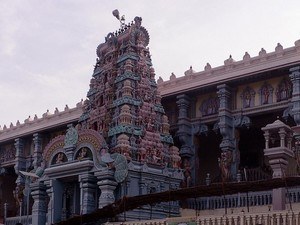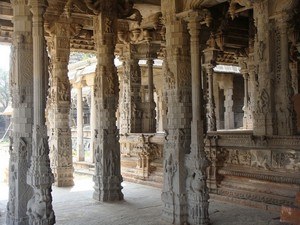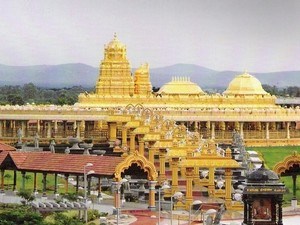Jalakandeswarar Temple, Vellore - Timings, History, Architecture, Best Time to Visit
Photo Credit: Flickr
 #2 of 24 Places to Visit in Vellore
#2 of 24 Places to Visit in Vellore
 Distance (From Vellore Town Railway Station): 1.5 Kms
Distance (From Vellore Town Railway Station): 1.5 Kms
 Trip Duration (Including Travel): 30 Mins
Trip Duration (Including Travel): 30 Mins
 Place Location: Inside Vellore Fort
Place Location: Inside Vellore Fort
 Transportation Options: Walk/Trek
Transportation Options: Walk/Trek
 Travel Tips: This place is situated inside Vellore Fort and visited as part of the Fort tour
Travel Tips: This place is situated inside Vellore Fort and visited as part of the Fort tour
About Jalakandeswarar Temple
At a distance of 1.5 Km from Vellore Town Railway Station, Jalakandeswarar Temple is an ancient Hindu temple located in the city of Vellore, precisely within Vellore Fort. Dedicated to Lord Shiva, it is one of the prominent attractions in Vellore Fort, and among the must visit places as part of the Vellore pilgrimage tour. The presiding deity here is called Jalakandeswarar as there is water below this Shiva Lingam. The name Jalakandeswarar is derived from two Sanskrit words - Jala meaning water and Khandeshwar meaning Lord Shiva. The temple is owned and maintained by the Archaeological Survey of India, with only the administration taken over by the Department of Hindu Religious and Charitable Endowments, Government of Tamil Nadu.
History & Mythology of Jalakandeswarar Temple
Jalakandeswarar Temple was constructed in the mid-16th century CE by Chinna Bommi Nayaka, a subordinate of Sadasivaraya from the Vijayanagara dynasty. According to local legends, the site originally featured a significant ant-hill surrounded by water accumulated from rainfall. A Shiva Lingam was established there and became an object of devotion for worshippers. Subsequently, Chinna Bommi Nayaka, the chieftain responsible for the fort, experienced a dream in which he believed Lord Shiva instructed him to build a temple at that location. Following this divine revelation, he proceeded to construct the temple in 1550 AD.
Unfortunately, the temple suffered damage during a Muslim invasion. During this tumultuous period, devotees managed to rescue the main deity's idol and relocated it to the Jalakanda Vinayakar Temple in Sathuvacheri, where it remained for many years. In 1981, the idol was discreetly returned to the fort, and the site was officially restored as a Hindu temple, now accessible to the public. The Archaeological Survey of India currently oversees the temple's management and preservation under the auspices of the Government of India.
Architecture of Jalakandeswarar Temple
Jalakandeswarar Temple stands as a remarkable representation of Vijayanagara architecture, featuring intricate carvings, sculptures, and paintings. The temple is situated in the center of a water tank with a circumference of 8000 feet, which is the origin of its name, Jalakandeswar Temple. Oriented towards the east, the structure includes a Garbhagriha, an Ardhamandapa, and a Mahamandapa, complemented by two courtyards that contain two Prakaras and gopurams. The principal gopuram rises over 100 feet, adorned with detailed depictions of deities, animals, and floral designs. Additionally, the temple features a Kalyana Mandapam (wedding hall) that showcases a dual-faced sculpture of a bull and an elephant. The engravings on the temple's ceilings and pillars are exceptionally intricate.
Within the sanctum sanctorum resides Lord Shiva in the form of a Shivalingam. The goddess Sri Akilandeswari Amman, the consort of Lord Jalakandeswarar, is enshrined in a separate sanctum located in the inner courtyard of the temple. Devotees can also view Vinayaka, Madeswari, Vaishnavi, Varahi, Lakshmi, and Saraswathi on the outer walls of the Amman sanctum. A statue of Nandi is positioned in front, facing the sanctum of Sri Jalakandeswarar. Furthermore, the temple includes a Madapalli, Yagasala, and a small stepped tank.
Behind the Nandi statue, there exists an earthen lamp that is believed to rotate when individuals place their hands upon it. This rotation is thought to signify the fulfillment of their wishes. Some devotees also venerate the golden and silver lizard sculptures, as well as the snake sculptures, seeking relief from 'sarpa dosham'.
Festivals of Jalakandeswarar Temple
The Jalakandeswarar Temple, located within Vellore Fort, celebrates a variety of festivals throughout the year. Notable events include Chitra Poornima, a ten-day festival held in April/May, Surasamharam in October/November, Aadi Pooram, a 10-day festival in July/August), Vinayaka Chaturthi in August/September, and Navratri in September/October. During these festivities, the temple is adorned with vibrant colors and lights, offering visitors an authentic glimpse into traditional culture and a lively spiritual atmosphere.
Dress Code & Other Restriction of Jalakandeswarar Temple
While there isn't a strict dress code for visiting the Jalakandeswar Temple, it's recommended to dress modestly and respectfully, covering your shoulders and legs, as a mark of respect for the temple's sanctity. Men are encouraged to wear a dhoti or pajama paired with an upper garment, as well as formal trousers and shirts. Women may opt for a saree, half saree, or churidhar. Avoid wearing nightwear, short pants, midis, short dresses, and bermudas.
Non-Hindus are welcome to explore the temple complex and appreciate its architectural beauty; however, access to the sanctum sanctorum may be restricted.
Jalakandeswarar Temple Timings
Monday: 6:30 AM - 1 PM & 5 PM - 8:30 PM
Tuesday: 6:30 AM - 1 PM & 5 PM - 8:30 PM
Wednesday: 6:30 AM - 1 PM & 5 PM - 8:30 PM
Thursday: 6:30 AM - 1 PM & 5 PM - 8:30 PM
Friday: 6:30 AM - 1 PM & 5 PM - 8:30 PM
Saturday: 6:30 AM - 1 PM & 5 PM - 8:30 PM
Sunday: 6:30 AM - 1 PM & 5 PM - 8:30 PM
Jalakandeswarar Temple Entry Fee
Entry is Free
Best Time to Visit Jalakandeswarar Temple
The optimal period to Jalakandeswarar Temple is during the winter months, specifically from November to February, when the weather is mild and enjoyable, allowing for a thorough exploration of the temple. Mornings are the most favorable time of day for a visit. Another suitable time to visit Jalakandeswarar Temple is during festivals including Chitra Poornima, a 10-day festival in April/May, Surasamharam in October/November, Aadi Pooram, a 10-day festival in July/August), Vinayaka Chaturthi in August/September, and Navratri in September/October.
How to Reach Jalakandeswarar Temple
Located approximately 126 kilometers from Vellore, Chennai International Airport serves as the nearest airport, offering extensive flight connections to nearly all major cities across India and internationally. Katpadi Junction, situated on the outskirts of Vellore, provides regular train services to various cities, including Chennai, Bangalore, Tirupati, Vijayawada, Mangalore, Trivandrum, and Coimbatore. The Vellore Bus Station is well-connected with frequent bus services to Chennai, Kanchipuram, Pondicherry, Chittoor, Tirupati, and Bangalore. The Jalakandeswarar Temple is situated inside the Vellore Fort, and can be reached by hiring an auto-rickhaw or take a bus from Vellore Railway Station, which is located about 1.5 kilometers away.
















